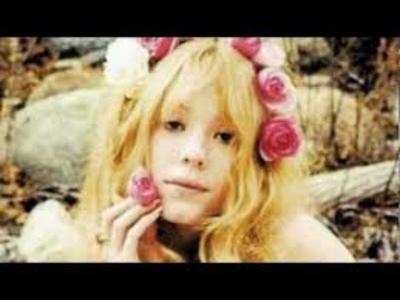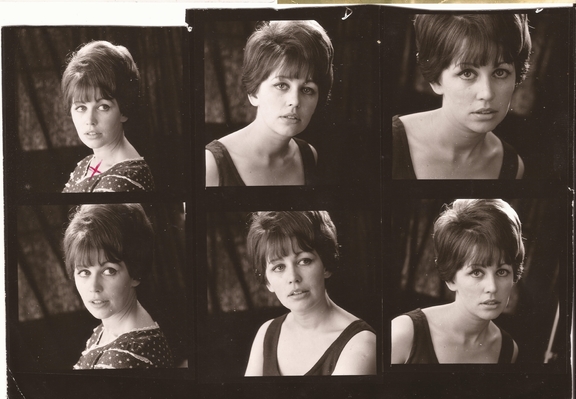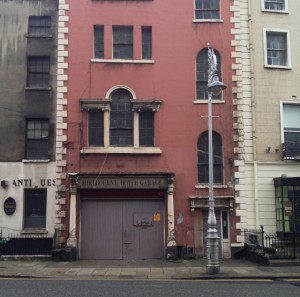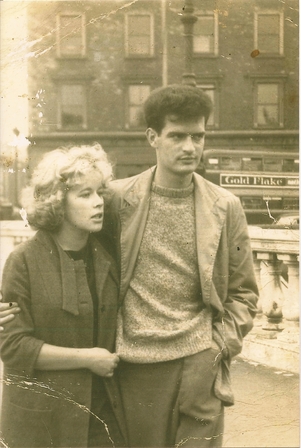
|
By Brian Rothery If the world as we experience it is a hologram and a performance in which we are all actors and in which some of us make our own performances, as in plays within plays, then this little story can be regarded as a projection within a grander projection. It would not have been possible to conceive and tell as it now stands without modern technology, because that technology has created a fundamental part of it. I begin with the image above. This is from the 'Man on Bridge' collection of photographs of the passing public on O'Connell Bridge in Dublin taken by street photographer, Arthur Fields, in 1951. It shows sisters Colette and Miriam Dunne when Colette was 14 and Miriam probably under 9. It was posted with this message: My sister Colette and myself wearing Dominican Convent Muckross Park blazers and Bradley's leather sandals. Bradley's shoe shop had an x-ray machine so you could see your foot measurements and skeleton toes. On the back of this photo dated 1951, I have written 'I hate you for 3 days because you always go to the pictures without me', so we must have been having a row, hence the cross faces. (i.e. pictures meaning going to the cinema.) (Miriam Dunne.) To find the image and this message you go to http://www.manonbridge.ie/ and search for Colette Miriam Dunne. The 'Man on Bridge' collection was also the subject of an RTE documentary in 2014. I wrote a first version of this story, assuming that the image and the words could not have been uploaded by either sister, for reasons which follow. I wrote, "Hopefully, someone reading this can explain how this image came to be posted." Now to the story which might never have been told if the image had not been conjured up by technology. A story about Colette and Miriam Dunne We lived in a somewhat magical place just under Barnacullia in County Dublin, where our back garden actually adjoined the Three Rock Mountain. This meant that by climbing over our back wall, we could follow paths to the summits of both the Three Rock and Two Rock mountains and to all the nooks and crannies and abandoned granite quarries near the base of the first mountain. These quarries were our favourite hideouts, with granite ledges where we could sit, small ponds from which we could fish for minnows with rushes and worms and over which in summer hovered the beautiful dragonfly, and stones and moss patches under which newts darted. My sister was three years younger than I and, just after she began to attend Muckross, a somewhat 'posh' south Dublin school for girls, one of her new friends, Colette, began to visit us. Colette's younger sister, Miriam, would sometimes accompany her. To appreciate the immediate impression that these two girls made on me, one needs to understand that it was in the years just after the Second World War, possibly from late 1946 to 1948. The norm for children those days, and for many adults, was plain and even ragged clothes, certainly dull or lacking colour. The very first characteristic of the sisters to impact on me was their exquisite dress and grooming, something I had never seen before. Colette was dark, Miriam blonde. I will continue with Colette and then return to Miriam. Colette I had little interaction with, or interest in, Colette at the time, except for one significant incident, which was to become a life-illuminating experience, when Colette and my sister were about eleven and I fourteen. That day my sister called me to the shed at the back of our house because Colette had come in contact with fresh paint which had stained the front of her dress. I reached for the turpentine while Colette stood, eyes lowered, demurely raising and holding out her dress for me to clean. I cannot say whether I knelt or merely stooped, but, during that hushed moment while I worked on it, I became aware of some sacred aura that seemed to encompass the scene. Years later I found a description in Joyce's Portrait of an artist as a young man when, on Sandymount Strand, Stephen Dedalus experienced a revelation upon seeing a girl of about the same age with raised skirts as she bathed her legs, also aware that she was an object of adoration. I was still too young to emulate Stephen's passion, but old enough to store the image for the future. "Heavenly God! cried Stephen's soul, in an outburst of profane joy. "Her image had passed into his soul for ever and no word had broken the holy silence of his ecstasy. Her eyes had called him and his soul had leaped at the call." That was the last time I saw Colette for almost 25 years. When I reached 17, I did what most boys of that age want to do - I found a 16 year old girl and happily embraced her as my life-long companion. Around sixteen years after the revelation in the shed, we returned from a six year stint in Canada to find that television had swept Ireland and a hugely popular British 'soap', possibly one of the first ever, was just ending a run of several years. It was 'Emergency Ward 10' and I never got to see any of its episodes. My brother informed me that our young sister's friend, Colette Dunne, had acted in it as an 'ice cold' nurse and that men, including himself, had been palpitating with desire all over Great Britain and Ireland. She had played the part of a 'Staff Nurse Lyle'. My slumbering image of her in our shed was briefly re-awakened. Today, it seems that no copies of the tapes recording the episodes she appeared in are available in film libraries. As Colette went back into my past and I got on with my own busy and mostly exciting life as a successful young executive, the rest of the 25 year interlude passed, until one day I hovered in the doorway of an antique shop beside my office on the banks of the River Liffey where some object on display had caught my attention.
Dublin Quays near Halfpenny Bridge The woman minding the shop called out to me by name. It was Colette, now thirty-six and virtually unrecognizable. I was astonished and went inside to greet her. She told me her sad story: peaking in her early Twenties as a young actress, then a slow decline through career setbacks, relationship break-up, alcoholism and depression. I was deeply saddened. I asked her what had happened to her little sister, Miriam, who was actually the more important of the two to me, and to my deep sadness she told me that, years before, she had joined a group and had died. I assumed that she had become a groupie, following a Sixties band. I heard nothing of Colette for many years and assumed that she had died, but just after the first version of this story appeared I learned that she had gone into permanent residential care. Miriam Some time after Colette's first visit to us under Three Rock Mountain, she began to bring Miriam with her. Miriam would have been four or five during the two years in question and I probably around thirteen. It was customary for me to show our mountain hideaways to all interested visitors. Once my sister's new school friends began to arrive, however, interest in what the mountain had to offer gave way to girlish chat and play back at the house, so I have no memory of Colette ever being with me 'up the mountain'. With Miriam it was an altogether different matter. Miriam not only fell for the mountain and its hideouts, but acquired what I later realized was a 'crush' for me. It could be a lesson for our times to appreciate that both my own mother and Miriam's considered it 'sweet' and altogether good and natural that a thirteen year old boy was taking a five year old girl up onto a deserted mountainside and doing it over two years. Our favourite place was one of the abandoned quarries with its partially moss covered granite ledges where we would sit. I have no memory of what we talked about, but, knowing what I was like back then, I probably told her stories. I do remember gentle hugs from her, natural, chaste, innocent. I had no indication back then that, as with Joyce's Sandymount Strand revelation, her image also was passing into my soul. But it was to be an even more profound impression than that made by the brief moment of beauty in the shed with her older sister, for, over the decades which followed, she became my Dantean Beatrice, even around the same age, remembered as she was under eight, but never again to be seen in the flesh in this mortal world. My initial image of little Miriam beside me on the granite ledge of the quarry or fishing with rushes in its pond never changed, but it was joined by the sad one of what she might have been like in her early Twenties when she joined the band. Blonde and pale, sad and skinny.
Camp follower, groupie. Oh foolish girl! For forty more years I carried these two images within my soul, sometimes wondering if the same eager expectancy and naive trust in me on the mountain, so plain to see later in her photograph on the bridge, had led her to her early demise. I even foolishly wondered if I had failed her by moving on and forgetting her. The very words I wrote in the first version of this story about doing what most boys of that age want to do - finding a girl of a similar age, suggest a sense, if not actually of betrayal, at least of loss. That twenty five year passage before my re-union with Colette expanded into sixty-six years, bringing old age and the passing of my dear wife who had also been my life's companion and to whom I had told the simple but sad story of the sisters. One day in January 2015, I was working on a philosophical construct of creation. I went for a walk on the sea shore and wrestled with some concept within it. I returned home and, for no apparent reason, keyed the expression 'Colette and Miriam Dunne' into the search engine. I had searched before but to no avail. To my utter astonishment, the image of the sisters walking across O' Connell Bridge in 1951 came up, and there, after sixty-six years since I last saw her in 1948, was Miriam, a hologram within the hologram of my imagination, all within the divinely projected hologram of our perceived existence. 1951 was the year I first dated the 16 year old who became my dear wife. It was three years after last seeing the sisters together. In the photograph, their beautiful clothes, sandals and Miriam's ribbon indicate that their mother was still looking after them. I then wrote and posted most of the above story and, convinced that Miriam, gone long before the Internet evolved, could not have uploaded the photo, I asked if anyone could tell me where it had come from. I suggested that someone may have obtained it from her photograph album. I ended my piece with these words. "Thank you, Creation, for the brief gift of these two beautiful girls." I hardly need remind readers that by now, believing that both sisters were long gone, I had opened up my heart and soul to the world. A number of weeks passed. Unless someone searched on the words 'Colette and Miriam Dunne' my little story would not be found and the person who posted the picture on the 'Man on Bridge' site would have no need to search. I might never know who the poster was. Had Colette told me she had a child? Perhaps that child had access to the family photo album. But it was just idle speculation, because neither in time nor in place did my little story belong to this world. Thus, unchanged, remained my milieu up to about 7 PM on the evening of February 6 2015, when a new message appeared in my In Box, announcing the subject matter of 'Colette and Miriam Dunne'. Someone had read the story and perhaps now had information for me about the source of the image. Was the mystery about to be solved? Who else knew the girls? Plenty of course would have known Colette. But was it possible that someone alive even knew her dear little sister? I clicked. I stared, stupefied! It was from Miriam! Miriam had neither become a groupie nor had she died and I will never know why Colette had told me this. Miriam was alive and well, an artist and a novelist, a mother and a grandmother, living with her husband on Sherkin Island. For Heavens sake! Sherkin Island! But this was not in my cosmological agenda. Dante's Beatrice was in Paradise, so he could safely pour out his Divine Comedy. Mind you, when he arrived in Paradise she still gave him a bit of an earful. How much worse it might have been for him had it turned out that she was still alive. With a husband! I had not put my name on the original story, so Miriam, taken aback to read that she had turned into a hippy and died forty years earlier, was asking who had written this story. As my faltering fingertips touched the keyboard to respond, I was thinking that it might not be Sherkin I'd be visiting but Devil's Island.
Colette leaves this mortal stage
Two months after this story began to be published here and after many years in residential care, Colette passed away during the night on April 6 2015. Her photograph with Lord Longford, taken at the height of her fame and beauty, hangs in the foyer of the Gate Theatre in Dublin. Just before the end of 2016, a man who had fallen in love with Colette at the height of her career, aware of this story or who had just seen it, brought it to the attention of his daughter, Siobhan. On New Year's Eve 2016, Siobhan contacted me to say that Colette was her mother and that she had walked out when she was five. Her father and her stepmother had brought her up and she now had two sons. It later transpired that Colette had been an admirer of the great Irish actress, Siobhan McKenna, and had named her daughter after her. Because of this development, it became possible to publish the next dramatic episode in Colette's life.
Colette at the height of her fame and beauty Colette went to Harrow Sometime after her appearances in Emergency Ward 10, Colette was playing the lead role in Shaw's Major Barbara in Malvern in Worcestershire. How striking she must have been in her Salvation Army uniform can be gauged by one man's reaction. The press was full of her as she had told them that George Bernard Shaw had appeared to her in her dressing room. The play's promoters must have been delighted. One result was that Harrow-educated Dale Vargas, a teacher in a local boys' school, brought along his whole class to see her perform. The boys must have loved her, but Dale certainly did and within weeks they were engaged. Colette was signed up for another tour but cancelled it and became Dale's wife. With this now beginning to look like the script from another Shaw play, Dale moved to a job in Harrow itself, where he would rise to at least assistant Head and write books such as The Timeline History of Harrow School: 1572 to Present, The History of Eton Fives,and Belmont Hassocks: The Rise and Demise of an English Preparatory School. Colette was not just the wife of an educated Englishman, but wife to a potential future headmaster of the famous Harrow boys school. One could be forgiven for saying "You really couldn't make it up."
In another universe it might have worked, with Colette slipping gracefully into Harrow life alongside the respectful and admiring Harrow boys, but, sadly, she became seriously unwell. When Siobhan was five, Colette fled. Although her family had rushed to try to stop the wedding, later Miriam would say that she is glad they failed because we now have Siobhan and her two boys. In 1952, The Quiet Man,starring John Wayne and Maureen O'Hara, captivated audiences around the world. Colette was 15 and it was the year after she and Miriam were photographed on the bridge. Even before the release of the movie, Maureen was already Ireland's first international super film actress and had been hailed in Hollywood as the 'Queen of Technicolor'. So even if she had not taken drama classes from the same teacher as Maureen, Colette would have been well aware of her. In 1939, 19 year old actress, Maureen O'Hara, had a whirlwind romance with and married an Englishman and film production assistant in Harrow, shortly before she left for Hollywood. He did not follow and two years later she annulled the marriage. Extraordinary contiguity There were, and still are, several points of contiguity in the story of the Dunne sisters, one of which as we shall see is quite extraordinary. They grew up in a small cul-de-sac called Annaville Park near Dundrum, south of Dublin. They went to Muckross school just off Ranelagh where Maureem O'Hara was brought up. During my school years, I would have passed Annaville Park daily on the Number 44 Enniskerry bus, the same bus the girls would use to come up to visit us under the mountain. Well within walking distance from Annaville Park and a short bus or bicycle ride for us was our local Emporium of Dreams, in those days mainly in black and white, the Odeon Cinema in Dundrum. My siblings and I were regulars as were the Dunne sisters. Indeed the quarry I visited with Miriam sometimes became another planet from the weekly Flash Gordon serial. Thinking back now, did Colette dream that one day she would be up there on the silver screen, not just below watching it? Alas, now there is a somewhat darker note, which my own romantic and beauty-endowed experiences of the sisters tempt me to ignore, while the reality of the events dictates otherwise. Annaville Park borders on Ireland's central mental asylum, known back then as the 'lunatic asylum'. Some residents on the Dunne's side of the road, whose back gardens ended at the southern wall of the facility, joked that their gardens were the first points of landing for escaping madmen. But now for what is surely the most extraordinary contiguity. Right across the road from the Dunne house in Annaville Park lived the Fricker family. Desmond Fricker was a public servant and a journalist in The Irish Times,while his wife Bina was a school teacher. In 1945, when Colette Dunne was eight, Brenda Fricker was born. In 1960, when, throughout Britain and Ireland, Colette was famous as Nurse Lyall in Emergency Ward 10, Brenda was 15 and, at the height of Colette's fame in 1962, when she starred with Roger Moore in The Saint, Brenda was 17.
Annaville Park around 1949. Top row, second from left, Miriam. Bottom row, second from left, Brenda Fricker. Third from left and tallest, Colette, probably 12. On that day in 1974 when I met Colette in the antique shop, unknown to me but possibly known to Colette, Brenda Fricker, still in herTwenties, was progressing as an actress. Three years later in January 1977, in one of her first TV roles, she was staff nurse Maloney in Coronation Street and then she really came to fame as Nurse Megan Roach in the BBC television drama series Casualty, which she quit in 1990 after 65 episodes. As a TV nurse, Brenda had truly eclipsed that other earlier beautiful Irish nurse from across the road. The peak of her subsequent highly successful movie and TV career came in 1989 when she was the first Irish actress to receive an Academy Award for her performance as Christy Brown's mother in My Left Foot. Twenty five years later, in 2014, Maureen O'Hara was awarded the Academy's Honorary Oscar, becoming the second actress, after Myrna Loy, to receive an Honorary Oscar without having previously been nominated for an Oscar in a competitive category. Credit for the success of these three actresses should also be given to a largely forgotten woman, Ena Burke, who ran the 'Ena Mary Burke School of Drama and Elocution' in Kildare Street in Dublin and whose 17 year old star pupil in 1937 was Maureen O'Hara. That was the year Colette Dunne was born. Seeing The Quiet Man in 1952, Ena must have believed that she was experiencing the apogee of her career.
Ena Mary Burke School of Drama and Elocution in Kildare Street
It's heartening to learn that just before Ena died in a London hospital Brenda Fricker and Miriam Dunne visited her. In an irony of ironies, in 2012, Brenda Fricker publicly revealed that she had suffered from depression for 50 years and had made numerous suicide attempts. The beginning of that depression would have been at the height of Colette's career in 1962 when Brenda herself was only 17. Brenda appeared to have experienced the acme of success and achieved the highest accolade, everything that her beautiful neighbour from across the road let slip through her fingers, but her admission in 2012 casts a new light on their lives. It is as if that grim Dundrum wall had truly cast its shadow over the lives of these two extraordinary actresses.
Still to come. Miriam and Syd As with many other Dubliners, I accepted Arthur Fields, the man on the bridge, as part of my natural landscape. Not a happy or cheerful part as he was a grim-looking sod, but perhaps unknown even to himself he was a sorcerer of sorts because his snaps are still causing special affects in the cosmos.
Arthur Fields
Contact us by email at ed-ectopia@live.ie Feel free to comment.
The British writer, Ben Capel, responds It's a hauntingly beautiful and moving story and something akin to it has been playing on my mind for some time: the creative effects of a dynamically evolving memory system borne of love, borne of that which exists beyond our conventional sense of 'reality', a dimension informed by the sacred erotic which can enrich (and deconstruct) the oppressive present and the future. I hope to elaborate shortly. I'll do my best to come back to you asap. The story is profoundly evocative and should act as a source of hope for those mired in a despairing present day 'reality'. Plato is conventionally read as suggesting that the perfection of the Absolute Idea (which I would suggest includes notions of justice, dignity, freedom and unbounded love) is the only true stability. The world of appearances, our 'reality', is full of contingency and error. But maybe there's another way of reading him: the Absolute Idea (love, dignity, liberty, justice, etc) is what is fleeting and fragile, and it requires our loving commitment to keep it alive in the face of a brutally homogenising and conformity-inducing 'reality'. I'll do my best to free associate to these thoughts when the material conditions of free association - the suspension of coercion and conformity - return. But my heart goes out to you. What an extraordinary turn of events. Sometimes, miracles do happen.
|








